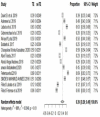Self-care practice among hypertensive patients in Ethiopia: systematic review and meta-analysis
- PMID: 34021068
- PMCID: PMC8144031
- DOI: 10.1136/openhrt-2020-001421
Self-care practice among hypertensive patients in Ethiopia: systematic review and meta-analysis
Abstract
Background: In high-income and low-income countries, including Ethiopia, hypertension (HTN) is a serious public health concern. As a consequence, a massive self-care practice (SCP) is necessary, and the domains of SCP, including adherence to medication, physical activity, weight management, low-salt diet, non-smoking, moderate alcohol usage, and dietary management, are required. However, there is no nationwide study on HTN SCPs in Ethiopia. This meta-analysis, therefore, aimed to estimate the pooled level of HCP among individuals living with HTN in Ethiopia.
Methods: The Preferred Reporting Items for Systematic Reviews and Meta-Analysis guideline was used to report this systematic review and meta-analysis. We systematically searched the databases PubMed/MEDLINE, Embase, Google Scholar and Science Direct for studies conducted in Ethiopia. All observational studies published until July 2020 were included. Data were analysed using R V.3.5.3 software, and the pooled prevalence with 95% CIs was presented using tables and forest plots. The presence of statistical heterogeneity (I2) within the included studies was evaluated. We used a funnel plot to identify evidence of publication bias. The random-effects meta-analysis model was employed to estimate the pooled proportion of good HTN SCPs.This was submitted for registration with the International Prospective Register of Systematic Reviews in March 2020 and accepted with the registration number CRD42020175743 (https://www.crd.york.ac.uk/PROSPERO).
Results: Our search databases produced 356 papers. Twelve of these papers fulfilled the inclusion and were found suitable for the review. The total population in this study was 3938. Off these hypertensive populations, 44% (95% CI 34 to 53) had good SCP. The subgroup analysis for each component of SCP was done. The subgroup analysis of good adherence to low-salt diet, alcohol abstinence, medication adherence, non-smoking, physical exercise and weight management was 52% (95% CI 39% to 66%), 77% (95% CI 69% to 88%), 65% (95% CI 45% to 85%), 92% (95% CI 88% to 95%), 43% (95% CI 30% to 56%) and 51% (95% CI 32% to 69%), respectively. In conclusion, nearly half of patients with HTN had good SCPs.
Keywords: antihypertensive drugs; hypertension; hypertensive heart disease.
© Author(s) (or their employer(s)) 2020. Re-use permitted under CC BY-NC. No commercial re-use. See rights and permissions. Published by BMJ.
Conflict of interest statement
Competing interests: None declared.
Figures










References
-
- WHO . World Health organization hypertension fact sheet 2019.
-
- Klabunde R. Cardiovascular physiology concepts. Lippincott Williams & Wilkins, 2011.
Publication types
MeSH terms
LinkOut - more resources
Full Text Sources
Other Literature Sources
Medical
Research Materials
Miscellaneous
